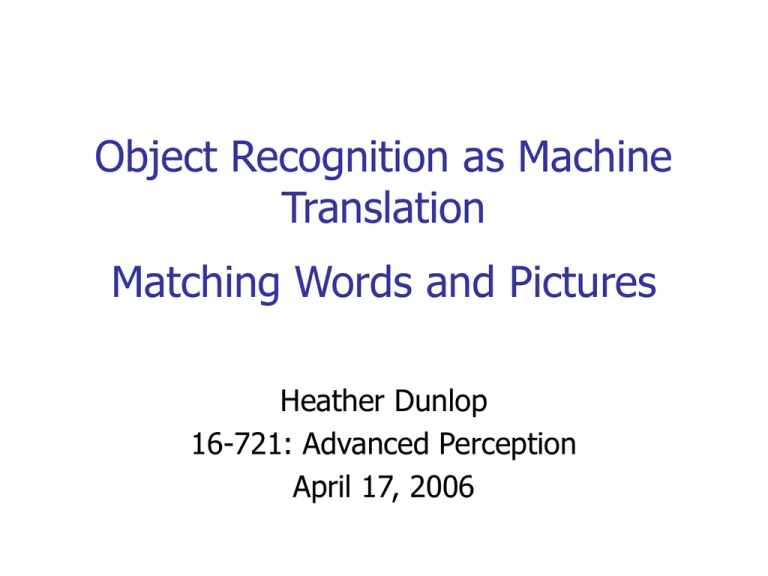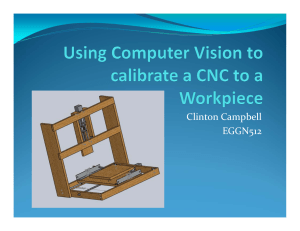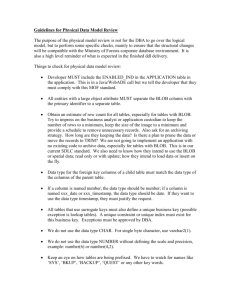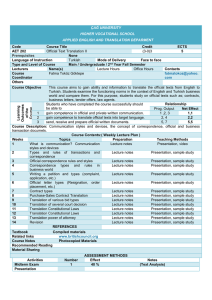Object Recognition as Machine Translation Matching Words and Pictures Heather Dunlop
advertisement

Object Recognition as Machine
Translation
Matching Words and Pictures
Heather Dunlop
16-721: Advanced Perception
April 17, 2006
Machine Translation
• Altavista’s Babel Fish:
– There are three more weeks of classes!
– Il y a seulement trois semaines supplémentaires
de classes!
– ¡Hay solamente tres más semanas de clases!
– Ci sono soltanto tre nuove settimane dei codici
categoria!
– Es gibt nur drei weitere Wochen Kategorien!
Statistical Machine Translation
• Statistically link words in one language to
words in another
• Requires aligned bitext
– eg. Hansard for Canadian parliament
Statistical Machine Translation
• Assuming an unknown one-one
correspondence between words, come up
with a joint probability distribution linking
words in the two languages
• Missing data problem: solution is EM
Given the translation
probabilities, estimate
the correspondences
Given the correspondences,
estimate the translation
probabilities
Multimedia Translation
• Data:
– Words are associated with images, but
correspondences are unknown
sun sea sky
sun sea sky
Auto-Annotation
• Predicting words for the images
tiger grass cat
Region Naming
• Can also be applied to object recognition
• Requires a large data set
Browsing
Auto-Illustration
Moby Dick
Data Sets of
Annotated Images
• Corel data set
• Museum image collections
• News photos (with captions)
First Paper
Object Recognition as Machine
Translation: Learning a Lexicon for a
Fixed Image Vocabulary
by Pinar Duygulu, Kobus Barnard, Nando de Freitas, David Forsyth
– A simple model for annotation and
correspondence
Overview
Input Representation
• Segment with Normalized Cuts:
sun sky waves sea
word tokens
• Only use regions larger than a threshold (typically
5-10 per image)
• Form vector representation of each region
• Cluster regions with k-means to form blob tokens
Input Representation
• Represent each region with a feature vector
– Size: portion of the image covered by the region
– Position: coordinates of center of mass
– Color: avg. and std. dev. of (R,G,B), (L,a,b) and
(r=R/(R+G+B),g=G/(R+G+B))
– Texture: avg. and variance of 16 filter responses
– Shape: area / perimeter2, moment of inertia,
region area / area of convex hull
Tokenization
Assignments
• Each word is predicted with some
probability by each blob
Expectation Maximization
• Select word with highest probability to assign
to each blob
# of words
# of images
# of blobs
N
Mn
Ln
p( w | b) p(anj i )t ( wnj | bni )
n 1 j 1 i 1
probability that
blob bni translates
to word wnj
probability of obtaining
word wnj given
instance of blob bni
Expectation Maximization
• Initialize to blob-word co-occurrences:
• Iterate:
Given the translation
probabilities, estimate
the correspondences
Given the correspondences,
estimate the translation
probabilities
Word Prediction
• On a new image:
– Segment
– For each region:
• Extract features
• Find the corresponding blob token using
nearest neighbor
• Use the word posterior probabilities to predict
words
Refusing to Predict
• Require: p(word|blob) > threshold
– ie. Assign a null word to any blob whose
best predicted word lies below the
threshold
• Prunes vocabulary, so fit new lexicon
Indistinguishable Words
• Visually indistinguishable:
– cat and tiger, train and locomotive
• Indistinguishable with our features:
– eagle and jet
• Entangled correspondence:
– polar – bear
– mare/foals – horse
• Solution: cluster similar words
–
–
–
–
Obtain similarity matrix
Compare words with symmetrised KL divergence
Apply N-Cuts on matrix to get clusters
Replace word with its cluster label
Experiments
• Train with 4500 Corel images
– 4-5 words for each image
– 371 words in vocabulary
– 5-10 regions per image
– 500 blobs
• Test on 500 images
Auto-Annotation
• Determine most likely word for each blob
• If probability of word is greater than some threshold,
use in annotation
Measuring Performance
• Do we predict the right words?
Region Naming /
Correspondence
Measuring Performance
• Do we predict the right words?
• Are they on the right blobs?
• Difficult to measure because data set
contains no correspondence information
• Must be done by hand on a smaller
data set
• Not practical to count false negatives
Successful Results
Successful Results
Unsuccessful Results
Refusing to Predict
Clustering
Merging Regions
Results
light bar = average number of times blob predicts word in correct place
dark bar = average number of times blob predicts word which is in the image
Second paper
Matching Words and Pictures
by Kobus Barnard, Pinar Duygulu, Nando de Freitas,
David Forsyth, David Blei, Michael I. Jordan
– Comparing lots of different models for
annotation and correspondence
Annotation Models
• Multi-modal hierarchical aspect models
• Mixture of multi-modal LDA
Multi-Model Hierarchical
Aspect Model
cluster = a path from
a leaf to the root
Multi-Model Hierarchical
Aspect Model
• All observations are produced independent of one another
observations
frequency tables
normalization
document
clusters
levels
• I-0: as above
• I-1: cluster dependent level structure
– p(l|d) replaced with p(l|c,d)
• I-2: generative model
– p(l|d) replaced with p(l|c)
– allows prediction for documents not in training set
Gaussian
Multi-Model Hierarchical
Aspect Model
• Model fitting is done with EM
• Word prediction:
set of
observed
blobs
Mixture of Multi-Modal LDA
multinomial
mixture component
and hidden factor
multinomial
Dirichlet
multinomial
multivariate
Gaussian
Mixture of Multi-Modal LDA
• Distribution parameters estimated with EM
• Word prediction:
posterior
Dirichlet
posterior over
mixture components
Correspondence Models
• Discrete translation
• Hierarchical clustering
• Linking word and region emission
probabilities
• Paired word and region emission
Discrete Translation
• Similar to first paper
• Use k-means to vector-quantize the set of
features representing an image region
• Construct a joint probability table linking word
tokens to blob tokens
• Data set doesn’t provide explicit
correspondences
– Missing data problem => EM
Hierarchical Clustering
• Again, using vector-quantized image
regions
• Word prediction:
Linking Word and
Region Emission
• Words emitted conditioned on observed blobs
BUW
• D-O: as above (D for dependent)
• D-1: cluster dependent level distributions
– Replace p(l|c,d) with p(l|d)
• D-2: generative model
– Replace p(l|d) with p(l)
Paired Word and Region
Emission at Nodes
• Observed words and regions are emitted in
pairs: D={(w,b)}
• C-0: as above (C for correspondence)
• C-1: cluster dependent level structure
– p(l|d) replaced with p(l|c,d)
• C-2: generative model
– p(l|d) replaced with p(l|c)
Wow, That’s a Lot of models!
•
•
•
•
•
•
Multi-modal hierarchical: I-0, I-1, I-2
Multi-modal LDA
Discrete translation
Hierarchical clustering
Linked word and region emission: D-0, D-1, D-2
Paired word and region emission: C-0, C-1, C-2
• Count = 12
• Why so many?
Evaluation Methods
• Annotation performance measures:
– KL divergence between predicted and target
distributions:
– Word prediction measure:
• n = # of words in image
• r = # of words predicted correctly
• # of words predicted is set to # of actual keywords
– Normalized classification score:
• w = # of words predicted incorrectly
• N = vocabulary size
Results
• Methods using clustering are very reliant on
having images that are close to the training
data
• MoM-LDA has strong resistance to over-fitting
• D-0 (linked word and region emission)
appears to give best results, taking all
measures and data sets into consideration
Successful Results
Unsuccessful Results
good annotation,
poor correspondence
complete failure
N-cuts vs. Blobworld
Blobworld
Normalized Cuts
N-cuts vs. Blobworld
Browsing Results
Clustering by text only
Clustering by image features only
Browsing Results
Clustering by both text and image features only
Search Results
• query: tiger, river
tiger, cat, water, grass
tiger, cat, water, grass
tiger, cat, grass, trees
tiger, cat, water, grass
tiger, cat, grass, forest
tiger, cat, water, grass
Auto-Illustration Results
• Passage from Moby Dick:
– “The large importance attached to the harpooneer's vocation
is evinced by the fact, that originally in the old Dutch
Fishery, two centuries and more ago, the command of a
whale-ship!…”
• Words extracted from the passage using natural
language processing tools
– large importance attached fact old dutch century more
command whale ship was per son was divided officer word
means fat cutter time made days was general vessel whale
hunting concern british title old dutch official present rank
such more good american officer boat night watch ground
command ship deck grand political sea men mast
Auto-Illustration Results
• Top-ranked images retrieved using all
extracted words:
Conclusions
• Lots of different models developed
– Hard to tell which is best
• Can be used with any set of features
• Numerous applications:
–
–
–
–
–
Auto-annotation
Region naming (aka object recognition)
Browsing
Searching
Auto-illustration
• Improvements in translation from visual to semantic
representations lead to improvements in image
access





